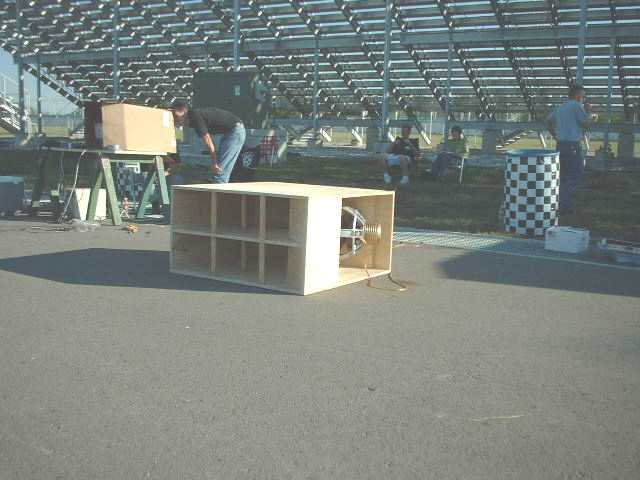I'm referring to the Rhino acoustics Bassmax horn subs:

FLH without RCC? Contradiction in terms?
This is what they have to say about it:
What do you guys think of the idea of removing the rear compression chamber? Does it actually give a better transient response, a more dynamic and uncoloured speaker?

FLH without RCC? Contradiction in terms?
This is what they have to say about it:
# How does BASSMAXX Technology make such deep bass? The very long BASSMAXX horn provides stable driver loading down to the lowest frequencies. The Box-Free design avoids the tendencies of rapid low frequency roll-off and driver unloading that occurs below resonance in all vented boxes. It also avoids the low frequency roll-off and terrible dynamic smother associated with all sealed boxes. (This includes horn cabinets that include a sealed or vented driver sub-enclosure.) The result is, that along with their unrivaled clarity and definition, BASSMAXX technology horns provide unparalleled low frequency extension.
What do you guys think of the idea of removing the rear compression chamber? Does it actually give a better transient response, a more dynamic and uncoloured speaker?
FLH without RCC? Contradiction in terms?
It is.
Skramstadt has some interesting thoughts on the sound of the RLH in his topic about the 6090 horn IIRC he created.
A drawback of a RLH is that there is an acoustic shortcut, depending on the horns length and driver position. For this reason scoops (a populair RLH design) show a gap in the frequency response around 70 -80 Hz, this also applies to for instance a transmision line. So long paths are favored.
If the path is very short and the VRC quite large than it's behauvior tends to be hybride between horn and basreflex which would deny some of the preferable horn general properties.
There are some drawbacks created by a FLH in contrast to a RLH, what exactly seems to have slipped my mind for the moment
Wkr Johan
Greets!
Duh! FLH sans RCC = BLH, ergo an optimized one can have the greatest CR, BW and it's the only horn alignment I know of that yields a ~'perfect' impulse response and flattest phase/impedance (excluding inductance rise). The trade-offs are they're very long due to needing a hyperbolic 'T' (aka 'M') factor, don't make nearly as much gain as a FLH is capable of or have the benefit of the rear chamber's driver protection, and suitable midbass/LF drivers available to the DIYer are made of unobtanium AFAIK.
FLH sans RCC = BLH, ergo an optimized one can have the greatest CR, BW and it's the only horn alignment I know of that yields a ~'perfect' impulse response and flattest phase/impedance (excluding inductance rise). The trade-offs are they're very long due to needing a hyperbolic 'T' (aka 'M') factor, don't make nearly as much gain as a FLH is capable of or have the benefit of the rear chamber's driver protection, and suitable midbass/LF drivers available to the DIYer are made of unobtanium AFAIK.
Not knowing any design details of the BASSMAXX, I can't comment on how close to ideal it is, but I assume it's not even close unless a number of them are stacked together to approximate an ideal termination.
FYI, the original RCA folded cinema basshorn prototype design that dominated until Altec Lansing debuted their 'A' series reflex FLH basshorns after WWII were close to an ideal BLH (as best I could tell with limited info) with the exception that the final termination was flat: http://www.audioheritage.org/html/profiles/lmco/shearer.htm If they'd had digital time delay back then, there probably wouldn't have been an Altec 'A' series.........
GM
Duh!
Not knowing any design details of the BASSMAXX, I can't comment on how close to ideal it is, but I assume it's not even close unless a number of them are stacked together to approximate an ideal termination.
FYI, the original RCA folded cinema basshorn prototype design that dominated until Altec Lansing debuted their 'A' series reflex FLH basshorns after WWII were close to an ideal BLH (as best I could tell with limited info) with the exception that the final termination was flat: http://www.audioheritage.org/html/profiles/lmco/shearer.htm If they'd had digital time delay back then, there probably wouldn't have been an Altec 'A' series.........
GM
Greets!
To compensate enough to keep peaking to a minimum like an annulled FLH, the horn has to expand very slowly from a small throat over a long distance for a low Qes driver; so yeah, the higher the Qes, the larger the throat, the faster the flare rate, the shorter its pathlength, but the larger its mouth.
GM
To compensate enough to keep peaking to a minimum like an annulled FLH, the horn has to expand very slowly from a small throat over a long distance for a low Qes driver; so yeah, the higher the Qes, the larger the throat, the faster the flare rate, the shorter its pathlength, but the larger its mouth.
GM
- Status
- This old topic is closed. If you want to reopen this topic, contact a moderator using the "Report Post" button.
- Home
- Loudspeakers
- Subwoofers
- front loaded bass horn without rear compression chamber?